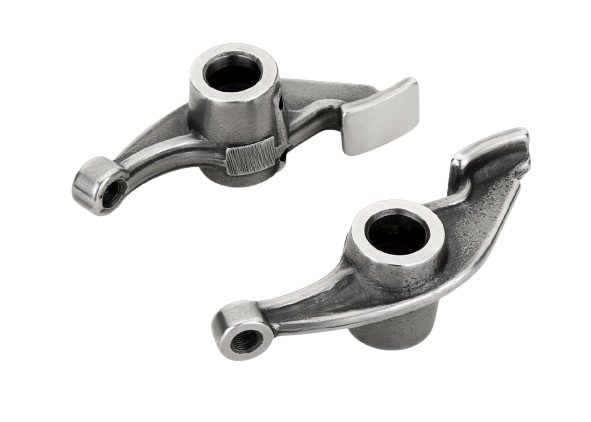Introduction
Engine rocker arms play a crucial role in an internal combustion engine, ensuring the proper movement of intake and exhaust valves. These components help convert the camshaft’s rotational motion into linear motion, allowing the valves to open and close precisely. In this guide, we will explore the different types of rocker arms and their functions in engine performance.
What is a Rocker Arm?
A rocker arm is a pivoting component in the engine’s valve train system. It transmits the movement from the camshaft to the valves, allowing controlled air and fuel intake and efficient exhaust gas expulsion. Rocker arms are typically made of steel, aluminium, or composite materials to balance strength and weight.
Types of Engine Rocker Arms
-
Stamped Steel Rocker Arms
- Made from a single piece of stamped steel.
- Lightweight and cost-effective.
- Common in standard production engines.
- May wear out over time and require periodic replacement.
-
Roller Rocker Arms
- Feature roller bearings at the contact points to reduce friction.
- Improve efficiency and valve actuation precision.
- Preferred in high-performance and racing engines.
- Available in steel or aluminium construction.
-
Shaft-Mounted Rocker Arms
- Mounted on a shaft running along the cylinder head.
- Provide improved stability and strength.
- Used in high-performance and heavy-duty applications.
- Require precise installation for optimal performance.
-
Pedestal-Mounted Rocker Arms
- Mounted on individual pedestals attached to the cylinder head.
- Common in overhead valve (OHV) engines.
- Easier to adjust and replace.
- Suitable for both stock and performance applications.
-
Die-Cast Rocker Arms
- Manufactured using die-casting techniques.
- Lightweight and cost-effective.
- Often used in mass-produced vehicles.
- May not withstand extreme engine conditions.
Functions of Rocker Arms
- Valve Operation: Rocker arms facilitate the opening and closing of intake and exhaust valves.
- Reduction of Friction: Advanced designs, like roller rocker arms, minimize friction, improving efficiency.
- Performance Enhancement: Aftermarket rocker arms can enhance power output and fuel efficiency.
- Durability and Wear Resistance: Modern materials and designs increase the longevity of the engine’s valve train.
Choosing the Right Rocker Arm for Your Engine
When selecting rocker arms, consider factors such as:
- Engine Type: Compatibility with overhead valve (OHV) or overhead camshaft (OHC) engines.
- Performance Needs: High-performance engines benefit from roller or shaft-mounted designs.
- Material Strength: Aluminum for lightweight performance, steel for durability.
- Maintenance Requirements: Some types require frequent adjustments, while others are maintenance-free.
Conclusion
Rocker arms are essential components that contribute to an engine’s overall performance and efficiency. Selecting the right type ensures optimal valve operation, reduced wear, and improved power output. Whether for daily driving or high-performance applications, understanding rocker arms helps in making informed choices for engine upgrades and maintenance.
For premium-quality engine components, including high-performance rocker arms, connect with Quintess Internationalyour trusted supplier of precision-engineered automotive parts!



